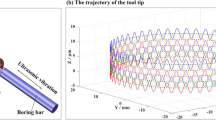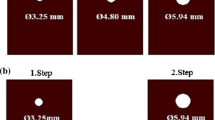Abstract
Aircraft skin, skeleton, and wing components contain a large number of riveted holes. There are few hole-making studies of double lug anchor nut connection 2024 aluminum alloy (Al2024) plates. To improve the quality of riveting holes on the anchor nut, two different hole-making schemes for two different sizes of holes on connection plate of the double lug anchor nut were proposed, and orthogonal experiments were conducted. The holes distributed on both sides were drilled, and the range analysis results and the optimal parameters were obtained: the spindle speed is 3000 r/min, and the feed rate is 0.04 mm/r. The coaxle hole with middle hole of nut was machined by the helical milling plan, the analysis results and the optimal parameters were obtained: the spindle speed is 3000 r/min, the feed rate is 0.08 mm/r, and the number of blade teeth is 4. Based on the obtained optimal parameters, the process sequence of first drilling and then helical milling (D + H) and first helical milling and then drilling (H + D) was proposed. In drilling, there is a significant fluctuation of force in the y-axis direction when using the process sequence of D + H. At the beginning of the helical milling experiment, the rising speed of the axial force of D + H is smoother than H + D. The deformation along the x-axis direction and the along the y-axis direction of the process sequence of D + H is 63.9 μm and 49.6 μm, which are 75.5% and 76.5% of H + D. Finally, experimental studies were carried out in the workshop. In drilling, the burr height is 77.1 μm, and hole diameter is 2.617 mm. In helical milling, the burr height is 20.7 μm, and the hole diameter is 5.023 mm. The deformation of the Al2024 is 64.3 μm. The optimal machining parameters and the process sequence of D + H can meet the technical requirements of connecting plate of the double lug anchor nut.





















Similar content being viewed by others
References
Duncheva GV, Maximov JT, Ganev N (2016) A new conception for enhancement of fatigue life of large number of fastener holes in aircraft structures. Fatigue Fract Eng Mater Struct 40(2):176–189
Vimalesh M, Prabhu S, Vijay Sekar KS (2015) Machinability studies in drilling of Inconel 718 super alloy. Appl Mech Mater 787:480–484
Tamer Ç, Ulvi Ş (2020) Design and test of a new step drill to reduce the operation time and increase the hole quality for CFRP materials. J Braz Soc Mech Sci Eng 42:553
Festas AJ, Pereira RB, Ramos A, Davim JP (2021) A Study of the effect of conventional drilling and helical milling in surface quality in titanium Ti-6Al-4V and Ti-6Al-7Nb alloys for medical applications. Arabian J Sci Eng 46:2361–2369
Sun Y, ** LY, Gong YD et al (2022) Experimental evaluation of surface generation and force time-varying characteristics of curvilinear grooved micro end mills fabricated by EDM. J Manuf Process 73:799–814
Jiang J, Shu X, Yong JH et al (2021) Development of metal cutting burr formation and control technology. Tool Eng 55(7):3–10
Zhang L, Liu Z, Tian W, Liao W (2015) Experimental studies on the performance of different structure tools in drilling CFRP/Al alloy stacks. Int J Adv Manuf Technol 81:241–251
Pramanik A, Basak AK, Uddin MS et al (2019) Burr formation during drilling of mild steel at different machining conditions. Mater Manuf Processes 34(5/8):726–735
Wang B, Zhao H, Zhang F et al (2021) Comparison of the geometric accuracy of holes made in CFRP/Ti laminate by drilling and helical milling. Int J Adv Manuf Technol 112(11):3343–3350
Wang Q, Wu Y, Li Y et al (2019) Proposal of a tilted helical milling technique for high-quality hole drilling of CFRP. Int J Adv Manuf Technol 101(1):1041–1049
Li S, Sui J, Ding F et al (2021) Optimization of milling aluminum alloy 6061–T6 using Modified Johnson-Cook Model. Simul Model Pract Th 111:9–12
Liu J, Zhao A, Wan P et al (2020) Modeling and optimization of bidirectional clam** forces in drilling of stacked aluminum alloy plates. Materials 12(13):1–19
Zhang X, Yu T, Wang W et al (2019) Improved analytical prediction of burr formation in micro end milling. Int J Mech Sci 151(2):461–470
Wang GD, Melly Kirwa S, Li N (2018) Experimental studies on a two-step technique to reduce delamination damage during milling of large diameter holes in cfrp/al stack. Compos Struct 188:330–339
Dong JS, Sun XY, Niu XY (2013) Comparison of orthogonal and uniform experimental design methods. Sci Technol Vis 22:78–78
Cai M, Gong YD, Yu N, Gao Q (2018) Simulation and experimental study on the milling force of aluminum alloy 6061 in micro-milling. J Northeast Univ 39(1):76–81
Liao YP, Yan QY (1984) Application of Orthogonal Test Method in Machinery Industry. Bei**g
Kim H (2020) Reduction of burr in rolling process through shear mechanism analysis. Int J Precis Eng Manuf 21:599–612
Fang WD, Lin YL, Li Y (2020) Study on drilling cutting force and hole-making quality of Kevlar composites. Compos Sci Eng 11:42–48
Yang GL, Dong ZG, Kang RK (2020) Research progress of helical milling technology. Acta Aeronaut Astronaut Sin 41(7):18–32
Liu Q (2016) Finite element analysis and experimental study on helical milling of titanium alloy. Harbin Institute of Technology
Wang B, Ma ZB, Liu N et al (2018) Study of helical milling in machining CFRP/Ti laminated materials with different number of edging mills. Modular Mach Tool Autom Manuf Tech 06:135–138
Zhao ZX (2021) Study on modeling and simulation force in milling process of aluminum alloy 7075-T6. University of Science and Technology Liaoning
Author information
Authors and Affiliations
Corresponding author
Ethics declarations
Conflict of Interests
On behalf of all authors, the correcting author states that there is no conflict of interest.
Additional information
Publisher's Note
Springer Nature remains neutral with regard to jurisdictional claims in published maps and institutional affiliations.
Rights and permissions
Springer Nature or its licensor (e.g. a society or other partner) holds exclusive rights to this article under a publishing agreement with the author(s) or other rightsholder(s); author self-archiving of the accepted manuscript version of this article is solely governed by the terms of such publishing agreement and applicable law.
About this article
Cite this article
Liu, G., Jiao, A., Li, X. et al. Study on Hole-Making Process of Connecting Plate of Anchor Nut. Exp Tech 48, 15–30 (2024). https://doi.org/10.1007/s40799-023-00642-4
Received:
Accepted:
Published:
Issue Date:
DOI: https://doi.org/10.1007/s40799-023-00642-4




